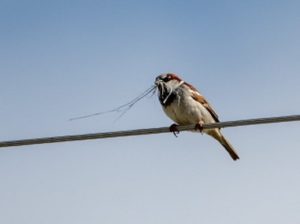Text and photos by Louisa Evers
Please see Part 1 for introductory information and more song birds too. Bird safely. Contribute to citizen science.
Swallows
Swallows are aerial songbirds with very short legs and bills and relatively long pointed wings. They feed almost exclusively on flying insects captured in graceful swooping flights. Tree swallows will also eat berries. Swallows commonly forage in groups over water and grassy areas and rest on exposed perches such as powerlines. Birders have seen three species of swallows so far this spring with a fourth probable.
Barn Swallow – Barn swallows nest almost exclusively on structures such as under bridges or house eaves. They forage over fields and ponds, so look for them over the marshy area and nearby fields. Barn swallows are dark blue-black above with orange undersides and foreheads. Unlike most other swallows, their tail is long and deeply forked with a white band.
Tree Swallow – tree swallows will nest in tree cavities or use nest boxes placed near water in open fields. These swallows are dark above and white below with metallic blue heads and backs in the right light. Look for tree swallows over the marshy area, ponds, and the Boise River.
Northern Rough-winged Swallow – rough-winged swallows are brown swallows with backs darker than undersides and white under the tail. Their tails are squarish instead of notched or forked. In flight, their wings look longer in proportion to their bodies as compared to other swallows. Look for rough-winged swallows over ponds and the Boise River.
Violet-green Swallow – violet-green swallows are just beginning to show up in areas along the Boise River. Violet-green swallows are smaller than tree swallows but can be mistaken for them. In the right light, however, their backs are distinctly green and purplish. Near the tail, white nearly wraps around the rump. While hard to see in these rapidly flying birds, the white in the face extends above the eye, whereas in tree swallows it remains below the eye. Look for violet-green swallows over ponds and the Boise River.
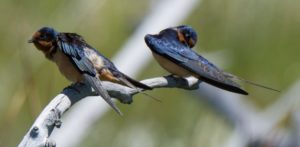

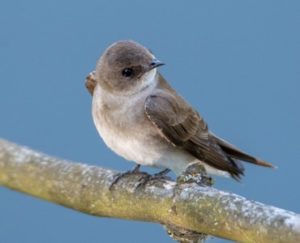
Kinglets
Kinglets are tiny, nervous, active birds that frequently flick their wings. Both species found in Idaho have olive bodies with color on their heads. Kinglets are often part of chickadee mixed flocks in winter. One species has been documented thus far at the park and the other may occur.
Ruby-crowned Kinglet – it’s possible that ruby-crowned kinglets only use the Park in winter since they prefer to nest in tall conifers. In winter they frequent shrubs and deciduous trees. When not with a chickadee flock, ruby-crowned kinglets are usually solitary and glean for tiny insects. The overall impression of these birds is a small, greenish yellow bird with no neck, a small bill, white in front and behind the eyes and a white wing bar. The ruby crown is seen only when the bird is agitated.
Golden-crowned Kinglet – as with ruby-crowned kinglets, golden-crowned kinglets may be present only in winter. Overall, golden-crowned kinglets are less common than ruby-crowned kinglets in the Treasure Valley. Golden-crowned kinglets are also small, no-neck birds with tiny bills, but have more conspicuous white and black stripes in the face and yellow on the top of the head. Like the ruby-crowned kinglet, the red in the crown is usually seen only with then bird is agitated.
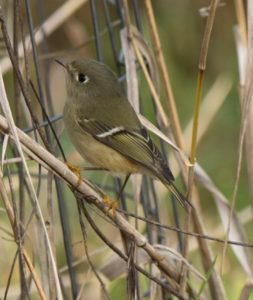
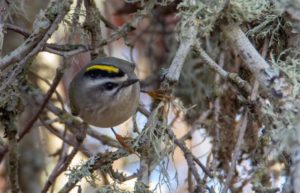
Wrens
Wrens are mostly small brown birds with narrow heads and long, slender bills. They tend to be secretive, creeping through underbrush or dense brush. Wrens are often seen perched with their tails cocked up above the back and are almost always solitary. Most nest in cavities, including bird houses, but a few build globular nests of sticks and grass. Most wrens sing a variety of songs and typically have harsh, scolding calls. Birders have seen two species of wrens with a third likely.
Bewick’s Wren – Look for Bewick’s wrens in dense brush around the marshy area and near Mill Slough. They have long tails that they flick from side-to-side making it look like their tail is not that firmly attached. Bewick’s wrens have barred tails and a white stripe over the eye, brown backs, and gray bellies. One of their songs is similar to a song sparrow but not quite right. If you hear a weird song sparrow, odds are it’s a Bewick’s wren.
Marsh Wren – As their name implies, marsh wrens are found in marshes. The one wren heard so far in the park was in the bulrushes near the Boise River. Marsh wrens are more often heard than seen, but their songs are quite distinct, making that the most reliable way to identify one. These little wrens are more reddish than brown, with barred tails, white stripe over the eye, and a v-shaped pattern on the back of black, brown, and white feathers.
House Wren – House wrens have not been documented as yet, but it’s a bit early for these migratory wrens. House wrens are typically found in dense brush and hedgerows and nest in cavities and bird houses. These are plainer brown wrens similar in size to a marsh wren and smaller than a Bewick’s wren. Their undersides tend to be gray.
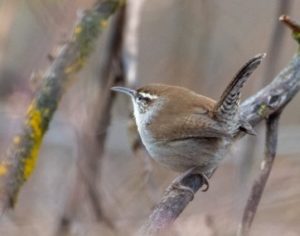
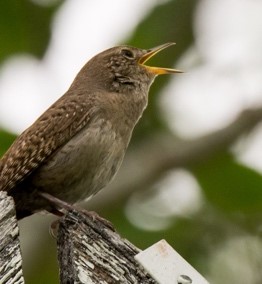
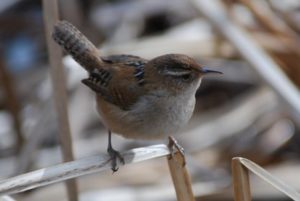
European Starling
This introduced bird is widespread and one of the most common birds around human developments. They nest in bird houses, crevices in buildings, and tree cavities. Starlings typically feed on the ground and can be found anywhere in the park. Their bills turn yellow during breeding and are blackish outside the breeding period. Generally black in appearance, starlings in fresh plumage have numerous white spots. However, over time these white tips to the feathers wear off leaving a bird that is glossy greenish-black in color. In certain lights, starlings can appear quite handsome, but generally these birds are treated as pests. They can be mistaken for our native blackbirds at first glance, but they have shorter tails, hold their wings in a more triangular shape reminiscent of fighter jets, and are stockier. Starlings form large flocks, especially in winter and if you see a tight, cohesive flock that shifts and shimmers, look for a hawk in the air nearby.
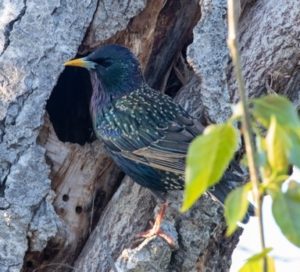
Thrushes
Thrushes are a diverse group of birds and includes familiar species such as robins, bluebirds, and other well-known songsters. Most have short, blunt-tipped bills and relatively long legs. Thrushes feed mainly on insects and fruit, usually on the ground. Two species of thrushes have been documented in the park.
American Robin – robins are probably our most familiar backyard bird and present year-round. Robins nest in open woodland or edge habitat so may be found throughout the park. They can form large flocks in winter but pair up by spring. Robins have gray backs with a darker head, white marks around the eyes, rusty-orange breasts and flanks, and dark tails with white corners. Females are paler than males. Robins are often the first bird to sing in the dawn chorus in spring.
Western Bluebird – Western bluebirds are common in any open woodland, but nest in conifer forests in Idaho. Middleton is too low for bluebirds, so the birds seen were just passing through during migration. During migration, they can be seen perching on fence posts or low branches while they look for insects. Western bluebirds have blue heads, wings, and tails, and chestnut breasts. Females are much paler, more grayish, than males.
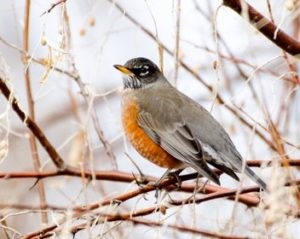

House Sparrow
Another introduced species, house sparrows are common near people. Like the starling, house sparrows nest in cavities, crevices, and bird houses. They are almost always in small flocks. Males have gray crowns, black bibs, grayish underparts, and brown “sparrow-patterned” backs. Females are quite plain and can be mistaken for house finches. These birds like densely crowned conifers, such as ornamental spruce trees and arborvitaes. Their song is a monotonous series of nearly identical chips. In the park, house sparrows are most often seen and heard in the trees near the adjoining subdivision.
